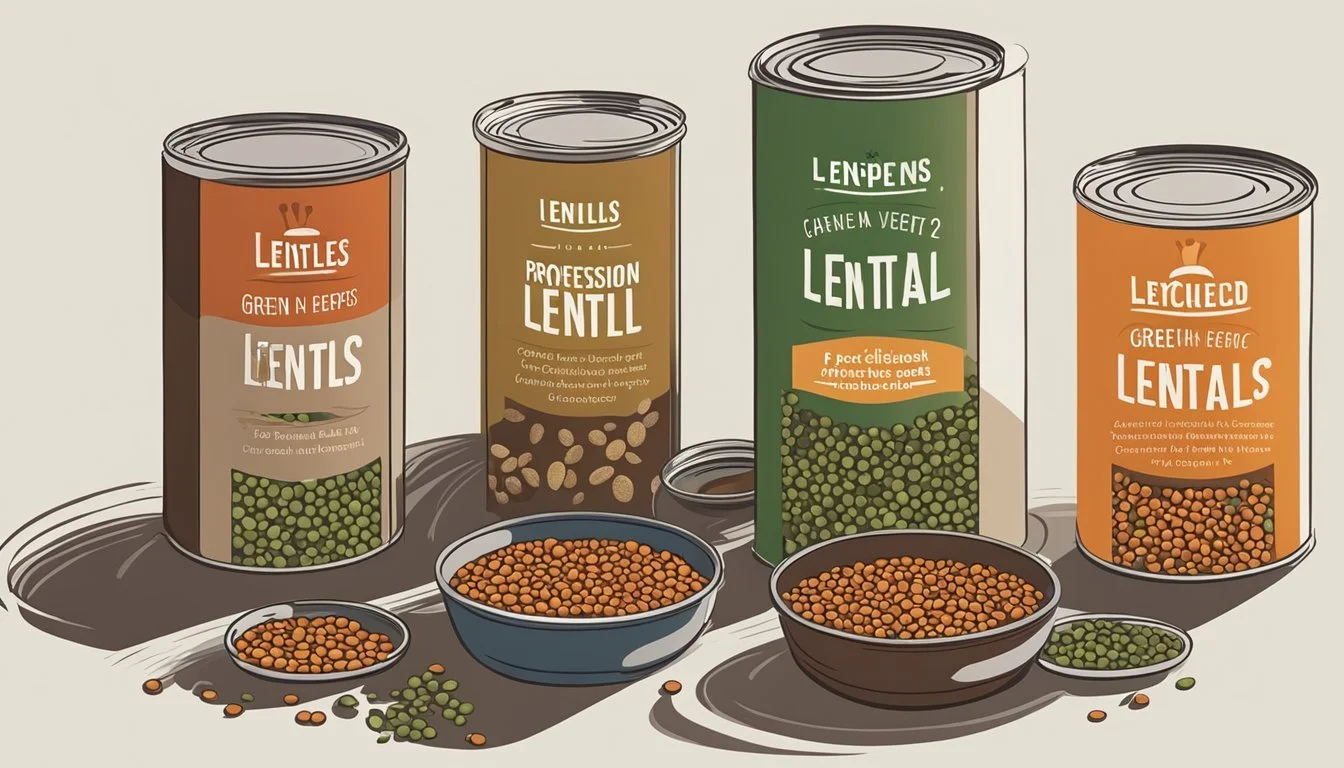Canned Lentil Recipes for Meatless Meals
Simple and Satisfying Dishes
Canned lentils are a versatile and convenient ingredient that can serve as the backbone for countless meatless meal options. These precooked legumes save time in the kitchen, allowing for the preparation of hearty and nutritious dishes without the lengthy cooking time dried lentils require. With their mild, earthy flavor, canned lentils can easily be incorporated into a variety of recipes, providing a substantial plant-based protein source that is both filling and easily digestible.
The rise of meatless meals has led to innovative and flavorful uses of canned lentils. From comforting soups and stews that promise warmth and satiety to creative takes on traditional meat-based favorites like sloppy joes and shepherd's pie, there is no shortage of recipes to explore. These dishes not only cater to vegetarians and vegans but also to those looking to reduce their meat consumption in favor of more sustainable and health-conscious alternatives.
Utilizing canned lentils in cooking not only contributes to a balanced diet but also aligns with environmentally friendly practices. Lentils have a lower carbon footprint compared to animal proteins, and using canned varieties means less preparation time and energy consumption. This makes them an ideal choice for quick weeknight dinners, make-ahead meals, and last-minute inspirations when time is of the essence. With the vast array of canned lentil recipes available, it's never been easier to introduce meatless meals into one's culinary repertoire.
The Benefits of Canned Lentils in Meatless Meals
Canned lentils serve as an excellent base for meatless meals, providing ample nutrition with the convenience of a ready-to-use ingredient. They are a staple in vegetarian and vegan diets, with good reason.
Nutritional Value: Canned lentils are a powerhouse of plant-based protein, making them a satisfying alternative to meat. They deliver a high content of protein, which is essential for muscle repair and growth, while also supplying important fiber for digestive health.
Protein: A key component for maintaining muscle mass and supporting bodily functions.
Fiber: Integral for digestive health and satiety, helping to manage weight.
Mineral Rich: Lentils are rich in minerals like iron and potassium. Iron is crucial for blood health, whereas potassium helps to regulate fluid balance and muscle contractions.
Mineral Importance Iron Vital for the production of hemoglobin in the blood Potassium Necessary for heart function and muscle contractions
Low in Unwanted Elements: They are low in calories, contain minimal saturated fat, and are free from cholesterol—all beneficial for heart health. Moreover, while they do contain some sodium, the content is manageable, especially if the lentils are rinsed before use.
Convenient and Cost-Effective: Canned lentils are precooked, saving time and energy in meal preparation—a boon for those who are busy but still wish to maintain a nutritious diet. They're also inexpensive, often costing less than their fresh or dried counterparts, making them accessible for budget-conscious consumers.
In summary, canned lentils contribute significantly to meatless meals with their protein content, essential minerals, low levels of undesirable elements, and their position as a cost-effective, ready-to-eat food product.
Understanding Lentil Varieties and Their Uses
Lentils are a staple in meatless meals, offering a variety of textures and flavors suited for dishes such as soups, stews, curries, and burgers. Here's how to choose the right type for your dish.
Green Lentils
Green lentils retain their shape well during cooking, which makes them ideal for salads and sides.
Texture: They have a slightly firm texture.
Flavor: These lentils have a peppery taste.
Common Uses: Perfect for lentil burgers and hearty salads.
Brown Lentils
Brown lentils are the most versatile and commonly used variety.
Texture: They become soft when cooked but can hold their shape if not overcooked.
Flavor: They have an earthy flavor, which makes them a good base for a variety of seasonings.
Common Uses:
Lentil Soup: Their ability to maintain a bit of firmness is ideal for a textured soup.
Lentil Stew: They thicken stews beautifully without turning to mush.
Red Lentils
Red lentils are a staple in Indian cuisine and are often used in dishes like dal because they cook quickly and break down easily.
Texture: These lentils become creamy when cooked, making them great for thickening dishes.
Flavor: They have a somewhat sweet and nutty flavor.
Common Uses:
Lentil Curry: Their creamy texture complements the spices in curries.
Lentil Soup: Produces a smooth and velvety soup.
Each lentil variety brings its unique qualities to the table. Selecting the appropriate one can greatly influence the texture and flavor of the meal.
Stocking Your Pantry for Canned Lentil Recipes
When preparing to create delectable meatless meals with canned lentils, a well-stocked pantry ensures convenience and variety. Canned lentils are a staple; they save time without the need for soaking and significantly reduce cooking time compared to their dried counterparts. For optimal freshness, it's best to store them in a cool, dry place away from direct sunlight.
Essential Pantry Items:
Canned Lentils: A selection of plain and possibly flavored varieties.
Olive Oil: A quality bottle for sautéing and adding a rich flavor base.
Onions and Garlic: Fundamental aromatics for depth in many recipes.
Herbs/Spices: A collection that may include but is not limited to rosemary, thyme, cumin, and coriander.
Vegetables: Diverse fresh or frozen vegetables such as carrots, celery, and tomatoes should be on hand to add nutrition and taste. Toxins do not easily accumulate in these items, making them safe and flavorful additions.
Building Blocks:
Vegetable Broth: For creating soups or adding depth to sauces.
Tomato Paste: A concentrated flavor enhancer that adds richness.
With these items readily available, an assortment of canned lentil recipes can be confidently approached, from hearty soups to vibrant salads. Their versatility and health benefits make them an essential component for meatless meal planning.
Essential Ingredients for Flavorful Lentil Dishes
In the quest for hearty and satisfying meatless meals, lentils provide an excellent base due to their nutritional value and versatility. To elevate lentil dishes, a combination of carefully selected ingredients is key.
Base Vegetables:
Most lentil recipes begin with a classic mirepoix, which includes onions, carrots, and celery. These ingredients form the foundational flavors. Adding garlic enhances the savor, whereas tomatoes introduce a pleasant acidity and richness. For a sweeter note, sweet potato can be incorporated.
Herbs and Spices:
The inclusion of spices and herbs significantly impacts the depth of flavor. Cumin gives an earthy warmth, black pepper adds a mild heat, and paprika provides a smoky undertone. For those who enjoy global flavors, curry powder can introduce a complex spice profile.
Spices Herbs Cumin Parsley Black Pepper Cilantro Paprika - Curry Powder -
Acidic Components and Heat:
To balance the earthiness of lentils, chefs often add an acidic element. Both vinegar and lemon juice brighten dishes, cutting through the richness. For an extra layer of flavor without meat, Worcestershire sauce, although traditionally made with anchovies, has vegetarian varieties that add a savory depth.
In summary, the key to delicious lentil dishes lies in the layering of textures and flavors. These ingredients contribute to creating a robust palate that satisfies the need for a meatless yet substantial component in any meal.
Preparing Canned Lentils for Culinary Use
Canned lentils are a convenient ingredient for meatless meals. They boast a soft texture and rich flavor, which make them a versatile addition to various dishes. To prepare canned lentils for culinary use, one should first ensure that they are ready to be integrated into recipes.
Rinsing is Critical: To begin, chefs should drain the lentils from their preserving liquid and thoroughly rinse them under cold water. This step helps to remove any excess sodium and the tinny taste often associated with canned goods, ensuring a cleaner flavor profile in the finished dish.
Texture Considerations: The texture of canned lentils is naturally softer than that of their dried counterparts. While this is an advantage for time-saving purposes, one must consider the cooking time when adding them to recipes to prevent overcooking.
Incorporating Ingredients: One can easily enrich soups, salads, and stews by adding canned lentils. They absorb flavors well, so pairing them with aromatic ingredients such as onions, garlic, and herbs enhances their taste.
Using Kitchen Tools: For recipes that require a smoother texture, lentils can be briefly pulsed in a food processor. Alternatively, for a quick warm-up, placing them in a microwave-safe dish is a convenient method to heat them efficiently without altering their texture.
Table of Nutritional Benefits:
Nutrient Benefit Protein Supports muscle repair Fiber Promotes digestive health Iron Essential for blood production
In conclusion, canned lentils are an easy and nutritious option for meatless meals. Chefs should emphasize the importance of rinsing and consider the desired texture when preparing them for various recipes, whether they aim for a quick microwave heat-up or the use of a food processor to refine the consistency.
Simple and Delicious Canned Lentil Recipes
Canned lentils are a convenient option for creating meatless meals that are hearty, filling, and equally nutritious. These versatile legumes can be transformed into a variety of recipes suitable for any meal of the day.
Lentil Soup: A classic choice, lentil soup is both easy to make and rich in flavor. To prepare, one can simply simmer canned lentils in a vegetable broth with a mirepoix of onions, carrots, and celery. Season with garlic, thyme, and a bay leaf to enhance the taste.
Ingredients Quantity Canned Lentils 1 can Vegetable Broth 4 cups Onion, diced 1 Carrots, diced 2 Celery stalks, diced 2 Garlic, minced 2 cloves Thyme 1 tsp Bay Leaf 1
Lentil Salad: A refreshing and easy option is a lentil salad. Mix canned lentils with chopped vegetables like cucumbers and tomatoes. Add a dressing of olive oil, lemon juice, salt, and pepper. Include feta cheese for extra flavor.
Lentil Curry: A simple lentil curry includes canned lentils, coconut milk, and a mix of curry spices like turmeric and garam masala. An addition of sautéed onions, tomatoes, and spinach can enrich the dish.
Lentil Burgers: They are delicious and straightforward to prepare. Process canned lentils with breadcrumbs, onions, and spices, then form patties to pan-fry until golden. Serve on buns with your favorite toppings.
Vegan Meatloaf: One can use canned lentils as a base for a vegan meatloaf, binding them with oats or breadcrumbs and adding a range of spices for a savory flavor similar to traditional meatloaf.
Each recipe showcases the versatility of lentils, confirming that one does not need to sacrifice taste for simplicity.
Innovative Ways to Enhance Lentil Dishes
Lentils, with their earthy flavor and hearty texture, serve as an excellent base for a myriad of meatless meals. To elevate lentil dishes, one can experiment with various ingredients that add both flavor and texture.
Sweet potatoes and potatoes are root vegetables that can add a comforting depth to lentils when roasted or mashed. They introduce a sweet note and a creamy texture that complements the firmness of cooked lentils. Incorporating these can transform a simple lentil stew into a more robust and satisfying meal.
For a contrasting texture, achieving a balance between soft lentils and crunchy elements is key. Consider adding a handful of fresh veggies such as bell peppers or zucchini during the last few minutes of cooking, or top your dish with some crispy kale or roasted chickpeas for an added crunch.
To enrich your lentil dishes with umami depth, cheese can be a game-changer. A sprinkle of feta cheese or grated Parmesan imparts a salty tang and increases the dish's richness.
Incorporating rice can turn a simple lentil dish into a complete protein meal. While it adds bulk, it offers a subtle flavor that won't overpower the lentils.
For those preferring a creamy consistency, coconut milk can be an excellent addition. When simmered with lentils, it infuses the dish with a mild sweetness and smooth, velvety texture that’s particularly complementary in spiced lentil soups or curries.
Lastly, do not overlook the power of greens. Kale and peas not only add freshness and pops of color but also provide additional nutrients. Stir into lentil soups or salads right before serving to keep their vibrant color and slight crunch.
Example Add-Ins for Texture and Flavor:
Ingredient Texture Contribution Flavor Contribution Sweet Potatoes Creamy and Soft Sweet and Earthy Rice Subtle and Soft Light and Nutty Kale Crunchy Fresh, Slightly Bitter Coconut Milk Velvety and Rich Sweet and Creamy
Experimenting with these mix-ins can elevate lentil dishes from a simple staple to a gourmet experience marked by layers of texture and complex flavors.
Health Considerations of Canned Lentils
Canned lentils are a convenient and nutritious option for meatless meals. They are an excellent source of plant-based protein, making them a popular choice for vegans and vegetarians alike, who may be looking to supplement their protein intake from non-meat sources.
In terms of fiber content, canned lentils are quite high, which is beneficial for digestive health. They also contribute to satiety, which can aid in weight management. Furthermore, lentils contain essential vitamins and minerals such as iron, which is crucial for oxygen transport in the blood, folate, important for DNA synthesis and repair, as well as potassium and magnesium which are vital for muscle function and maintaining a healthy blood pressure.
However, it is important to note that canned lentils may contain higher levels of sodium compared to their dry counterparts due to the canning process. It's advisable to rinse them under water to reduce the sodium content, making them a healthier choice, especially for individuals monitoring their sodium intake.
For those with special dietary requirements, canned lentils offer several benefits. They typically don't contain trans fat, and most varieties are naturally gluten-free, though it's essential to check the labeling for any cross-contamination if this is a dietary concern.
In terms of mineral content, while lentils provide calcium, levels are usually not as high as in other foods. Consumers may want to ensure they get enough calcium from other dietary sources.
In conclusion, canned lentils are nutritionally dense, providing key nutrients beneficial for a healthy diet, while also requiring some consideration, particularly regarding sodium content, to maximize their health benefits.
Proper Storage and Preservation of Lentil Leftovers
Storing leftovers efficiently is crucial for maintaining quality and safety. Lentil leftovers from canned lentil dishes can be kept fresh and flavorful when handled with care.
In the Refrigerator: For short-term storage, place the lentil leftovers in an airtight container. They should be refrigerated within two hours of cooking to inhibit bacterial growth. Properly stored, cooked lentils remain safe to consume for 3-5 days in the fridge.
Tips for Refrigeration:
Use clear containers to easily identify contents.
Label containers with the date to track freshness.
Freezing Lentil Leftovers: Lentils freeze well, which offers an extended shelf-life option. To freeze, ensure the lentils have cooled down. Then, portion them into meal-sized quantities in airtight containers or freezer bags, leaving some space at the top as they will expand.
Freezing Guidelines:
Thaw frozen lentils in the fridge overnight.
Consume thawed lentils within 3-4 days.
The Importance of Airtight Containers: Airtight storage prevents contaminants and absorbs less odors from other foods. It also reduces moisture ingress, which is critical in maintaining texture and preventing spoilage.
To Summarize:
Refrigerate in airtight containers for 3-5 days.
For longer preservation, freeze lentils, taking care to use an airtight container or bag.
Always label and date leftovers before storing.
Thaw frozen lentils in the refrigerator and use promptly.
Pairing Lentils with Other Foods for Balanced Meals
Lentils serve as a versatile base for creating hearty, meatless meals that can be both satisfying and nutritionally complete. The key to a balanced meal is to combine them with a variety of other foods that complement their flavor and boost their nutritional profile. Here's how one can pair lentils with select foods:
Salad: A lentil salad can be a light yet fulfilling meal. One should mix in vegetables like tomato and cucumber, and finish with a tangy dressing. Adding feta cheese introduces a creamy texture and a salty flavor accent.
Potatoes: Potatoes, rich in carbohydrates and vitamin C, can be a good partner to lentils. They can introduce a smooth and comforting element when served mashed or provide a delightful crunch when roasted.
Rice: Rice and lentils together create a complete protein. A dish such as lentil curry served over steamed rice is not only filling but also a staple in many cultures.
Bread: Whole grain breads provide a fiber-rich addition to a lentil-based meal. Whether as a side or as part of a lentil sandwich, bread complements the nuttiness of the lentils.
Beans: Combining different types of beans with lentils can introduce new textures and flavors while contributing additional protein and fiber.
Veggies: Roasted or steamed vegetables such as carrots, broccoli, or bell peppers add color, vitamins, and an extra serving of fiber to a lentil dish.
Herbs: Fresh herbs like parsley or cilantro can brighten a lentil dish, adding a fresh burst of flavor and a touch of greenery.
A balanced lentil meal considers nutrition, variety, and palatability. By pairing lentils with the right complementary foods, one can ensure their meatless meals are both enjoyable and wholesome.










